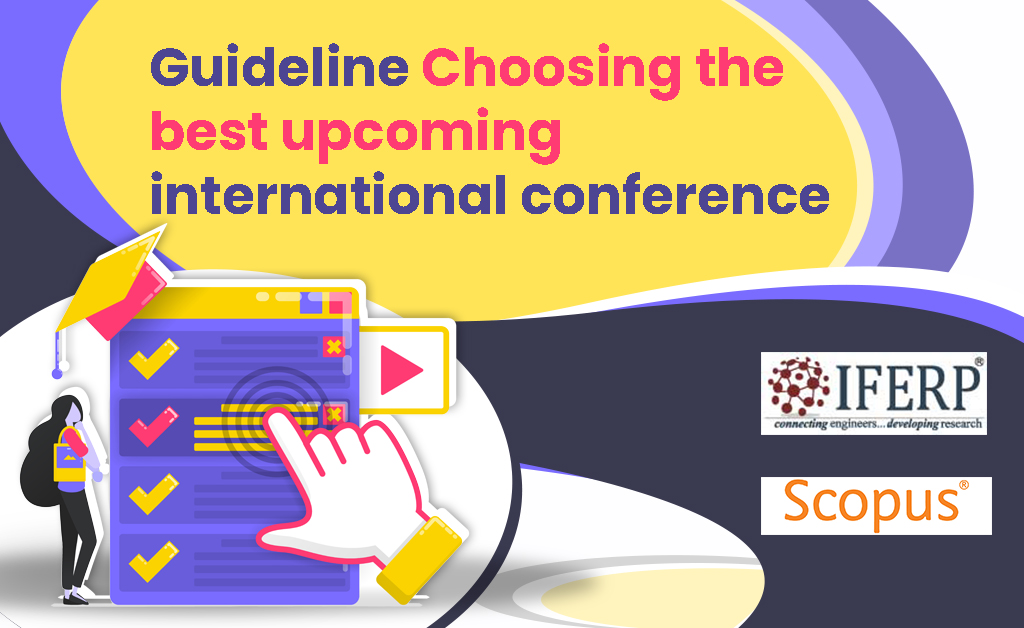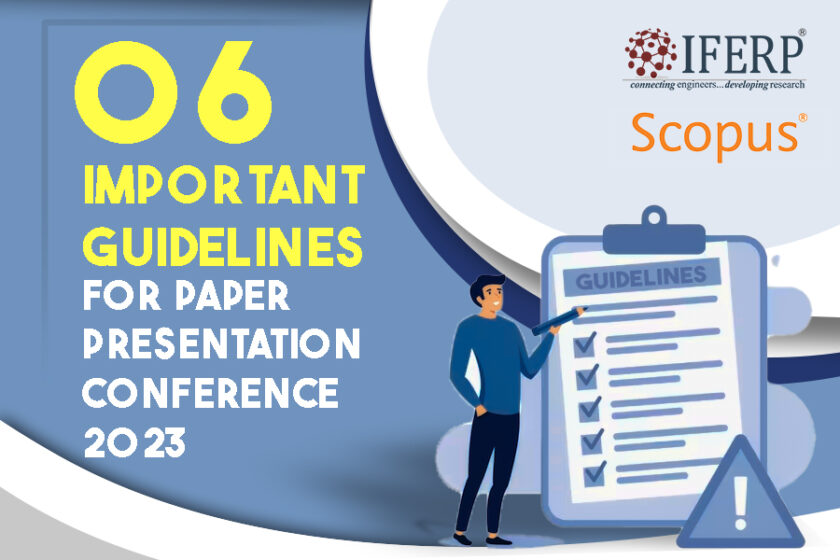Imagine standing on a stage in front of a large audience of distinguished academics, researchers, and industry professionals, presenting your latest research findings at a major international conference. You have prepared for months, meticulously researched your topic, and put together a compelling presentation. All eyes are on you as you begin to speak, and you can feel the weight of their expectations on your shoulders. Will you be able to captivate your audience, convey your ideas clearly, and answer their questions with confidence? The truth is, delivering paper presentations at major international conferences can be a daunting task, but it’s also an opportunity to showcase your research, gain valuable feedback, and make connections with experts in your field. In this blog, we’ll go over the key strategies and best practices for being successful at delivering paper presentations at major international conferences. From crafting a compelling message and designing an effective presentation to mastering your delivery and handling questions from the audience, we will cover everything you need to know to deliver a winning presentation that leaves a lasting impact on your audience.

- Guideline #1
Identifying A Worthy Conference To Pre
- Choosing the best upcoming international conference to present at is an important step in the research process.
- Attending a conference allows you to connect with fellow researchers, learn about the latest research in your field, and share your own research with a wider audience.
- However, with so many international conferences to pick from, it can be challenging to identify which one is right for you.
- Here are some key steps to follow when identifying the best international conference to present your research paper at.
- Define Your Research Interests
- Before you start looking for a conference to attend, it’s important to define your research interests.
- What are the key areas of research that you are interested in?
- What are the latest trends and developments in your field?
- Knowing the answers to these questions can assist in identifying conferences that are most relevant to your research.
- Before you start looking for a conference to attend, it’s important to define your research interests.
- Conduct A Literature Review
- A literature review can help you identify the best international conference with Scopus publication in your field.
- Look for papers published in reputable journals or conferences and see where they were presented.
- This will equip you with an idea of the most important conferences in your field.
- Check The Conference Schedule
- Once you have identified a few potential conferences, check the schedule to see if they cover the topics you are interested in.
- Look at the keynote speakers and session topics to get a sense of the conference’s focus.
- Consider The Conference Location
- The location of the conference can also be an important factor to consider.
- Are there any travel restrictions or visa requirements that you need to be aware of?
- Are there any cultural or language barriers that you need to take into account?
- Consider these factors when selecting a conference.
- The location of the conference can also be an important factor to consider.
- Look For Funding Opportunities
- Many conferences offer funding opportunities for attendees, such as travel grants or discounted registration fees.
- Look for conferences that offer these opportunities and apply for them as early as possible.
- Check The Reputation Of The Conference
- The reputation of the conference is an important factor to consider.
- Look for conferences that are well-established and have a good reputation in your field.
- Check the conference’s website, read reviews and feedback from past attendees, and ask colleagues for recommendations.
- Consider The Audience
- The audience of the conference can also be an important factor to consider.
- Look for conferences that attract researchers and practitioners who share similar research interests and goals as you.
- Guideline #2
Making Sure To Follow All The Submission Guidelines To A Tee
- When submitting a paper for presentation at a conference, it is crucial to follow all of the abstract submission guidelines imposed by the conference.
- These guidelines may include requirements for formatting, length, language, and more.
- Failing to follow these guidelines can lead to the disqualification of your paper, so it’s important to carefully read and understand the guidelines before submitting your paper.
- Here are some key steps to follow to make sure you follow all of the submission guidelines for a paper presentation imposed by a conference.
- Review The Submission Guidelines
- The first step is to carefully read and review the submission guidelines provided by the conference.
- Make sure to take note of any specific formatting requirements, word limits, or other requirements.
- Create A Checklist
- To ensure that you don’t miss any important requirements, create a checklist of all the guidelines you need to follow.
- This checklist will serve as a reference guide for you as you prepare your paper for submission.
- Format Your Paper Correctly
- Follow the formatting guidelines provided by the conference, including font size, spacing, margins, and style.
- Use the correct referencing style as required by the conference.
- Check For Language Requirements
- If the conference requires submissions in a specific language, make sure that your paper meets the language requirements.
- If you aren’t a native speaker of the language, consider hiring a proofreader or editor to review your work.
- Edit & Proofread Your Paper
- Before submitting your paper, edit and proofread it carefully to ensure that it is free from errors and meets all of the submission guidelines.
- Review your paper for clarity, accuracy, and coherence.
- Submit Your Paper Before The Deadline
- Submit your paper before the submission deadline, allowing plenty of time to ensure that all the requirements have been met.
- If possible, submit your paper a few days in advance to avoid any last-minute complications.
- Guideline #3
Prepare A Solid PPT
- Preparing a top-notch PowerPoint (PPT) presentation for an international conference requires careful planning, attention to detail, and effective communication skills.
- A well-designed and well-delivered PPT can significantly enhance the impact of your research and help you engage with your audience more effectively.
- Here are some key steps to follow when preparing your PPT for an international conference.
- Understand Your Audience
- Before you start preparing your PPT, you need to understand your audience.
- Who are they?
- What is their level of expertise?
- What are their interests?
- Knowing the answers to these questions can assist you in tailoring your presentation to the needs and interests of your audience.
- Before you start preparing your PPT, you need to understand your audience.
- Define Your Key Message
- The next step is to define the key message or main idea of your presentation.
- What is the main point you want to convey to your audience?
- Once you have defined your key message, you can structure your presentation around it.
- Create An Outline
- The outline is the backbone of your presentation.
- It should include the main sections and sub-sections of your presentation.
- Your outline should be logical and easy to follow, and each section should flow smoothly into the next.
- Use A Clear & Concise Format
- The format of your PPT should be clear and concise.
- Use bullet points, images, and graphs to convey your ideas effectively.
- Avoid using excessive text or complex graphics that can distract your audience.
- Choose An Appropriate Color Scheme
- The color scheme of your PPT should be appropriate for your topic and audience.
- Choose a color scheme that is easy on the eyes and does not distract from the content of your presentation.
- Use High-Quality Images & Graphics
- High-quality images and graphics can significantly enhance the impact of your presentation.
- Use clear and relevant images that support your key message.
- Avoid using low-quality or irrelevant images that can detract from your presentation.
- Practice Your Delivery
- The way you deliver your presentation is just as important as the content of your PPT.
- Practice your delivery in advance and time your presentation to ensure that it fits within the allotted time.
- Speak clearly and confidently, and engage with your audience by making eye contact and using gestures.
- Get Feedback
- Before you present at the international conference, get feedback on your PPT from colleagues or other experts in your field.
- They can help you identify areas for improvement and provide valuable insights that can help you refine your presentation.
- Guideline #4
Practice Every Part Of Your Presentation
- Delivering a paper presentation at a major international conference can be a daunting task, but effective practice can help to boost your confidence and ensure that you deliver a polished and engaging presentation.
- Practicing your presentation in advance can help you to refine your message, identify any problem areas, and gain familiarity with your material.
- Here are some key steps to follow when practicing your paper presentation for a major international conference.
- Develop A Practice Schedule
- It’s important to create a schedule for practicing your presentation in the lead-up to the conference.
- Allocate specific times for practice sessions, and aim to practice several times per week in the weeks leading up to the conference.
- Develop A Practice Schedule
- Time Your Presentation
- Start by timing your presentation to make sure that it falls within the allotted time frame.
- Most conference presentations are limited to a specific amount of time, so it’s important to make sure that your presentation is within the given time frame.
- Refine Your Message
- Practice refining your message and focus on key points that will resonate with your audience.
- Make sure that your presentation is structured in a logical and coherent way and that it builds towards a clear conclusion.
- Use Visual Aids
- If you plan to use visual aids such as slides, it’s important to practice using them effectively.
- Make sure that your slides are clear, easy to read, and effectively illustrate your key points.
- Practice Your Delivery
- When practicing your presentation, focus on your delivery.
- Pay attention to your pace, tone of voice, and body language.
- Practice making eye contact with your audience, and use appropriate gestures to emphasize key points.
- Seek Out Expert Guidance
- Practicing your presentation in front of colleagues or friends can be a great way to get feedback on your delivery and message.
- Ask for constructive feedback and make changes accordingly.
- Record Yourself
- Consider recording yourself delivering your presentation so that you can review it later and identify areas for improvement.
- You can also share the recording with colleagues or friends for additional feedback.
- Attend IFERP workshops and courses if you’d like help with this.
- Guideline #5
Nailing The Q&A Session That Follows Your Presentation
- Delivering a paper presentation at a top international conference is a significant achievement, but the Q&A session that follows the presentation can be just as important.
- The Q&A session gives you the opportunity to engage with the audience, clarify any points made in the presentation, and demonstrate your expertise.
- A successful Q&A session can help to reinforce the key points of your presentation, establish your credibility, and foster valuable professional connections.
- Here are some key steps to follow to ensure a successful Q&A session after delivering a paper presentation at a top international conference.
- Be Prepared
- The Q&A session can be unpredictable, so it’s important to be prepared for a wide range of questions.
- Consider the topics and themes of your presentation, and anticipate the types of questions that you may be asked.
- Think about potential questions that might challenge your arguments or that delve deeper into your research.
- Think about the best way to portray your research to the editors of top journals and publications, who will be in attendance.
- Listen Carefully
- When responding to questions, it’s important to listen carefully to the question being asked.
- Make sure you fully understand the question before providing an answer.
- Repeat The Question
- To ensure that the entire audience can hear and understand the question, it is often helpful to repeat the question before answering it.
- Keep Your Answers Concise
- It is important to keep your answers concise and to the point.
- Try to provide a direct response to the question asked while avoiding unnecessary details or tangents.
- Use Examples & Anecdotes
- Using examples and anecdotes can help to illustrate your points and make your responses more engaging and memorable.
- Be Respectful
- It’s important to be respectful and courteous when responding to questions, even if the question may be challenging or difficult to answer.
- Avoid becoming defensive, and always remain professional.
- Following Up After The Session
- Following up with audience members after the session can help to build connections and establish valuable professional relationships.
- Consider offering to answer any additional questions via email or providing resources for further reading on the topic.

- Guideline #6
Approaching Domain Experts For Feedback On Your Presentation
- Receiving feedback from domain experts after delivering a paper presentation at a conference is a valuable opportunity to refine your research and improve your skills.
- Domain experts have the knowledge and expertise to provide detailed and constructive feedback on your presentation, which can help you to develop your research further and improve your future presentations.
- However, approaching domain experts for feedback can be intimidating, particularly if you don’t know them well.
- Here are some key steps to follow when approaching domain experts for feedback and tips for writing a research paper after delivering a paper presentation at a conference.
- Identify Potential Domain Experts
- Start by identifying potential domain experts who may be interested in your research and have expertise in the area you presented on.
- Look for people who have published articles, given presentations, or have specific research interests that relate to your presentation.
- Craft Your Request
- Once you have identified potential domain experts, craft your request for feedback.
- Be specific about the areas you would like feedback on and provide any additional materials, such as your presentation slides that may be helpful.
- Send A Polite & Professional Email
- Send a polite and professional email introducing yourself and your research, and explain that you are seeking feedback on your recent presentation.
- Be respectful of their time and expertise, and offer to provide any additional information they may need.
- Be Patient
- It may take some time for domain experts to respond to your request for feedback, so be patient and avoid sending follow-up emails too soon.
- Be Open To Constructive Criticism
- When receiving feedback, be open to constructive criticism and avoid becoming defensive.
- Remember that domain experts are providing feedback to help you improve your research and presentation skills.
- Ask Follow-Up Questions
- If there is anything that you do not understand or would like more information on, do not hesitate to follow up with the domain experts.
- Asking follow-up questions can help you to gain a better understanding of the feedback provided and identify specific areas for improvement.
- You can also ask them to refer a fast publishing list of Scopus journals.
- Thank Them For Their Time
- After receiving feedback, be sure to thank the domain experts for their time and expertise.
- Let them know that you appreciate their feedback and that you will use it to improve your research and future presentations.


